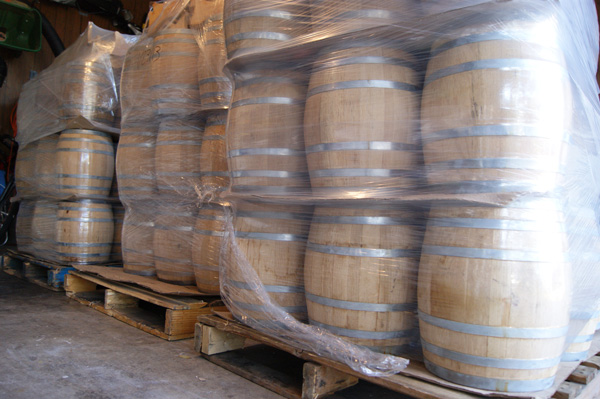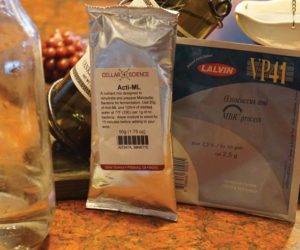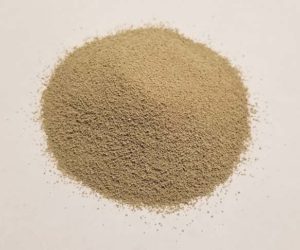Q
Winemakers who age in barrels are always talking about the percentage of “new oak” in their barrel lineup. If I put my wine in all two-year-old barrels, (second usage) how would you translate that into a percentage of “new oak” in the wine?
Richard Parry
Fox Fire Farms Winery
Ignacio, Colorado
A
Thanks for bringing up this topic. There are some parts of the answer that’ll be really obvious but like so much in winemaking, it’s often up for interpretation and the subtleties may vary from winemaker to winemaker, even in the professional world.

Let’s lay a little groundwork with the “obvious”: If you put all of your wine in new barrels (first usage), that’d be considered “100% new oak.” If, in your barrel lot (a grouping of barrels that contains the same homogenous wine from the same mother source), you’ve got one un-used barrel and one neutral barrel (has seen at least four season’s use), then that’s clearly “50% new oak.” If your barrel lot consists of two barrels, which have seen at least four season’s use, then that’s “0% new oak” or “100% used oak” or “100% neutral oak.”
After that, it’s a bit open to interpretation. That’s because the definition of what constitutes a “season’s use” can vary from winery to winery and from wine style to wine style. Additionally, barrels are made from natural materials and as such may have slight variations, especially between wood sourced from different countries and wood toasted in different ways. Typically a big red wine like a classic Cabernet Sauvignon stays in barrel for about 18 months and is bottled the winter after the subsequent harvest, while a lighter wine like Pinot Noir is aged in wood for about nine months and is typically bottled right before the next harvest comes up. For both of these wines, a “season’s use” for each wine is half or double that of the other.
For this reason, I tend to refer to “season’s use” rather than one- or two-year-old barrels . . . as I also buy barrels throughout the year and then feather them into my aging programs, it actually works best for me to track months of exposure rather than strict barrel age. Commercial wineries have fancy barcode scanning programs that track each barrel’s individual history but you can easily use a permanent marker to give a unique code to each of your barrels and track its history with a spreadsheet. That way you’ll always know how much “new wood” character any given barrel will contribute to your wine.
Don’t forget — you can also move wine around among barrel ages and types during its aging process. I’ve got a buddy who loves making super-oaky Cabs and used to joke that his wine was “200% new oak” — he achieved that by aging his new wine in brand-new barrels for about 10 months then racking the wine into another set for another 10 months before bottling the big (but too oaky for my tastes) wine. Expensive, sure, but he did get some good scores over the years, and it’s a bit of a funny story to tell as it’s indicative of his over-the-top personality.
Don’t forget — you can also move wine around among barrel ages and types during its aging process.
In the situation you describe, you’ve got all your wine in what sounds like a second-season use. If it’s a big Cabernet and you’ll be aging it in those same barrels for about 12–18 months, I think you can say you’ll get 30–50% “new wood” character out of it. The amount of new wood flavor and aromas a barrel contributes doesn’t decline in a straight line and will depend somewhat on the alcohol levels of the wines you’re making (higher alcohol extracts wood components faster). Barrels tend to lose their ability to impart new wood character after three to four season’s use but always maintain their ability to add roundness and improve mouthfeel because of the lees contact and micro- and macro-oxygenation that occurs during aging and monthly topping.
The world of barrel-aging and gauging of new oak impact is more an art than a science. Do what I always recommend, which is take good notes, and you’ll be able to build up a body of knowledge over the years.
Q
I made about 21 gallons (80 L) of wine with Sangiovese grapes and Lalvin EC-1118 yeast. No other additives were used. I should have used a yeast nutrient. My wine smelled like boiled eggs. I added about nine copper nails and copper pipe tube straps. I let them sit in the wine for about a month. The wine has a slightly less “eggy” smell. It now tastes very metallic/coppery. How would you remedy this?
Craig Bedard
Calgary, Alberta
A
Ah yes, Monday morning quarterbacking is always tough when it comes to wine. Adding a complex yeast nutrient (a mix of nitrogen, amino acids, and other micronutrients) is something I do with every fermentation. I have the luxury of being able to send my musts and juices to a wine lab to measure their amino acid and nitrogen content, but even when the available nitrogen levels are sound (about 300 ppm YAN or yeast assimilable nitrogen) I still add a tiny bit of a DAP-free complex yeast nutrient mix to make up for any deficiencies but not further increase nitrogen levels. Indeed, it’s most often a lack of nutrition that makes a fermentation, and the resulting wine, smell like rotten eggs (hydrogen sulfide).
Adding copper is certainly something that can help, but, rather than dumping in bits from the hardware store, next time use measured and metered amounts of a copper sulfate solution (CuSO4). You can buy CuSO4, along with directions for use, from many winemaking suppliers. Because too much copper can be toxic to humans, and because it seems like you have over-added, I must caution you to not drink this batch of wine. There is the possibility of using hydrogen peroxide to remove residual copper, but this Hail Mary is usually reserved for commercial winemakers who have to salvage a batch for economic reasons. The cure can sometimes be worse than the disease; hydrogen peroxide is a powerful oxidant and can ruin your wine just as equally as excess copper can. You could send a sample to a wine lab like ETS Labs (www.etslabs.com) to have it tested for residual copper but testing is expensive. Your easiest, cheapest, and safest bet is to throw out this batch and start again. Adding copper is best done by using the smallest amount of copper sulfate solution you need to make the needed aromatic improvement, then making the addition and testing for residual copper afterwards to make sure your wine is safe to drink.
A note from the Wine Wizard: It’s very strange to be writing a part of this column with a note to all of you, rather than you writing to me. You should also know something else about me: I’m a likely coronavirus survivor. I say “likely” because, as of the time of writing (3/19/20) in Napa County, California where I live, there still are not enough tests to go around. So may I present some tips for all of us moving forward in this strange new world. As winemakers, we all have a bit of a head start in my opinion since proper cleaning and sanitation is (or should be) part of our routines already.
What’s the difference between cleaning and sanitizing?
Cleaning refers to the manual removal of dirt, soil, and grime on an item or a surface. Sanitizing is the next step, which, when done right, kills off the omnipresent germs such as viruses and bacteria. Spraying a surface with a diluted bleach solution (see below for the recipe) after you cleaned it and letting the bleach solution sit for a minute then rinsing or wiping it off, will santize. But a disinfectant sanitizer will not kill germs unless the surface has first been cleaned. Happily, mechanical scrubbing with soap and water does double-duty against coronavirus (SARS-CoV-2 virus that causes the COVID-19 disease) because the hydrophobic/hydrophilic nature of the virus particle means that it’s destroyed by the interaction with a detergent and water. This is why doctors recommend we wash our hands with soap and water for at least 20 seconds as much as we can . . . and the same reason we should always wash our winemaking equipment first before the sanitation step.
A disinfectant must have enough contact time, be used at the correct concentration, be applied to a clean, dry surface, and be appropriate against that particular organism. The CDC (Centers for Disease Control and Prevention) website (www.cdc.gov) has a lot of information detailing specific commercial and industrial chemicals and sanitizers that are approved for killing the SARS-CoV-2 virus and includes specific brand names, concentrations, and contact times.
How can I make my own sanitizing agents that are effective against SARS-coV-2?
The CDC says that if you’ve got household bleach (check the expiration date), isopropyl alcohol, or even good old 3% hydrogen peroxide in your medicine cabinet, you can make your own sanitizing solutions. I’ve made one of each kind, and put the solutions in clean, dry household spray bottles for easy application. I also bought about 40 washcloth-sized microfiber towels to use as washable wipes. Once you’ve used either a paper towel or a washable cloth to wipe a surface, assume that the towel’s got germs and viruses on it and either throw disposables away in a lined trash can or wash cloth rags immediately. Don’t forget to regularly sanitize your laundry baskets, or to launder their washable liners.
While sanitizing with spray solutions, it’s best to wear an N95 facemask if you have one, in order to protect your lungs from inhaling chemicals. If you don’t have an N95 mask, a scarf or bandana wrapped around your nose and mouth will still block larger droplets. Try to keep the area well ventilated so you’re diluting the amount of sanitizing solution that may reach the air around you. Regularly spray down high-traffic areas and surfaces such as switch plates, doorknobs, countertops, sink faucets, refrigerator door handles, and the door of the microwave. Over the year’s you’ve heard me ask you to “think like a microbe.” Now instead of wine invaders, we’re talking human invaders. Just like with winemaking, be sure to clearly label and date each spray bottle and keep out of reach of curious little kids. If you have older kids, rope them in on making these solutions and using them and you’ll cover a little math, chemistry, and P.E. all in one helpful homeschooling exercise!
Homemade sanitizing solutions against SARS-CoV-2:
• Bleach: 1⁄3-cup bleach to 1-gallon water (or 4 tsp. per quart of water) check expiration date, contact one minute.
– Only use bleach on surfaces that can handle it, i.e. it’s probably not best to use on fabrics, upholstery, or wood that you want to protect from bleaching.
– Don’t forget that bleach is a no-no in your cellar and around your winemaking equipment because the chlorine molecule could possibly contribute to a TCA (trichloroanisole) taint in your wine. Keep it reserved for your kitchen, bathrooms, and bedrooms . . . don’t get it near your winemaking equipment!
• Alcohol (ethanol or isopropyl alcohol): The CDC recommends a minimum 60% for ethanol-based sanitizers and minimum 70% concentration for isopropyl-based, contact 30 seconds.
– Sadly, vodka and most commercial tipples are not strong enough to kill coronaviruses as they only clock in at about 40% ethanol. That said, Technical Editor Bob Peak adds “Since some states allow sale of Everclear or other neutral spirits at 190 proof (95% ABV), you could include a distilled-water dilution formula for those lucky residents of enlightened states. Using Pearson’s Square, I get that a 750 mL bottle of Everclear plus 438 mL of distilled water will land you at 60%. You can use it on things like wine thieves without the toxic (. . . er, as toxic) residue of isopropyl.”
– I use a 70% solution of isopropyl alcohol to sanitize my phone. Spray it on a microfiber cloth and wipe the phone and case with the damp cloth. Don’t saturate your phone or spray alcohol solution directly into the buttons or screen.
• 3% Hydrogen Peroxide: 3% is the usual concentration when sold in pharmacies and is effective with a 3-minute contact time, making it best for hard surfaces like stainless steel, tile, ceramics, and some plastics.
– Hydrogen peroxide loses its potency when exposed to air. Buy a new bottle after open for a while.
Can I use my winemaking sulfur dioxide solution or spray to kill SARS-CoV-2?
I did quite a bit of poking around on the internet and couldn’t find anything relating sulfur dioxide gas, potassium metabisulfite powder, or liquid SO2 solutions to combat SARS-CoV-2. Don’t forget that yeast and bacteria, which we’re always trying to control as winemakers, are living organisms and viruses technically are not. What may be useful against the former may not work on the latter; it’s safest to stay within the CDC’s guidelines for sanitizing solutions against the novel coronavirus. Please also remember that SO2 in any form is an inhalant hazard and can severely irritate lung tissue. If you’re suffering from COVID-19 or are recovering from it, you’re going to want to minimize your exposure to SO2 in any form and take extra precautions if using during your home winemaking activities.
What about a hand sanitizer, can I make my own?
While some health experts are in disagreement whether you should, there is no doubt that if done properly, it should effectively kill germs. The important thing is to make sure that you’re accurately measuring the ingredients and that you end up with about a 70% solution. Higher concentrations are not healthy for your hand’s skin and lower concentrations are not effective against the virus. WineMaker’s own Dave Green sent me his homemade hand sanitizer recipe:
–5 tablespoons of aloe vera to 1 cup 91% isopropyl alcohol. However, he did one better and broke out his scale so he knew exactly the amounts of his materials and could calculate a 70% solution: 2.4 oz. aloe to 8 oz. isopropyl alcohol. If you have a scale feel free to do this. If not, approximate measurements should work, but err on the high side of the equation for the alcohol concentration if anything.
But don’t forget good old soap and water can work even better and most doctors I’ve talked to would prefer us to wash our hands well at the sink with for 20 seconds or more instead of slathering on the hand sanitizer. Wash your hands when you can and reserve the hand sanitizer for those times you aren’t near soap and a sink.
My dearest, dearest readers . . . we’ve been together on this crazy home winemaking journey for more years than I can count (OK, since 1998 to be exact . . . I think). I’ve been so honored that you’ve trusted me to impart what I hope is wizardly advice for your winemaking questions and I’ll be thrilled if any of the above helps keep you or your families safer and healthier during this protracted germy “bad guy bug” phase in our lives. We got this WineMaker readers. Over and out, from your loving (and sanitized!) Wine Wizard.






